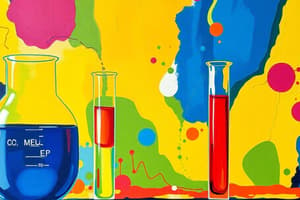Podcast
Questions and Answers
What is the purpose of the titrant in a titration?
What is the purpose of the titrant in a titration?
- To neutralize the excess acid or base in the solution
- To measure the volume of the analyte
- To indicate the end point of the reaction
- To react with the analyte in a known concentration (correct)
What is the difference between the equivalence point and the end point in a titration?
What is the difference between the equivalence point and the end point in a titration?
- The equivalence point and the end point are the same thing.
- The equivalence point is the point where the indicator changes color, while the end point is the point where the reaction is complete.
- The equivalence point is the point where the analyte is consumed, while the end point is the point where the titrant is consumed.
- The equivalence point is the point where the reaction is complete, while the end point is the point where the indicator changes color. (correct)
What is the purpose of using a standardized titrant solution in a titration?
What is the purpose of using a standardized titrant solution in a titration?
- To indicate the end point of the reaction
- To ensure the titrant has a known concentration (correct)
- To neutralize the excess acid or base in the solution
- To measure the volume of the analyte
What type of volumetric equipment is typically used to measure the volume of titrant added during a titration?
What type of volumetric equipment is typically used to measure the volume of titrant added during a titration?
What is the purpose of using an indicator in a titration?
What is the purpose of using an indicator in a titration?
What information can be obtained from a titration curve?
What information can be obtained from a titration curve?
What is a key requirement for a successful titration?
What is a key requirement for a successful titration?
Which of the following indicators may not be suitable for the titration described in the text?
Which of the following indicators may not be suitable for the titration described in the text?
What is the relationship between the equivalence point and the pH value?
What is the relationship between the equivalence point and the pH value?
Why is it important for a titration reaction to have a well-defined endpoint?
Why is it important for a titration reaction to have a well-defined endpoint?
What is the purpose of using an indicator in a titration?
What is the purpose of using an indicator in a titration?
In the given titration, what could happen if there was an interference from a foreign substance?
In the given titration, what could happen if there was an interference from a foreign substance?
What is the purpose of standardization in the context of the text?
What is the purpose of standardization in the context of the text?
In volumetric analysis, what is the significance of the end point?
In volumetric analysis, what is the significance of the end point?
What is observed at the equivalent point during titration?
What is observed at the equivalent point during titration?
Which piece of volumetric equipment is specifically used for measuring precise volumes of solutions?
Which piece of volumetric equipment is specifically used for measuring precise volumes of solutions?
What is the role of a burette in volumetric analysis?
What is the role of a burette in volumetric analysis?
Why is an indicator used during titration?
Why is an indicator used during titration?
Flashcards
Titrant
Titrant
A solution of known concentration used to react with the analyte in a titration.
Analyte
Analyte
The substance of unknown concentration being analyzed in a titration.
Equivalence Point
Equivalence Point
The point in a titration where the moles of titrant exactly equal the moles of analyte.
End Point
End Point
Signup and view all the flashcards
Standardized Titrant
Standardized Titrant
Signup and view all the flashcards
Burette
Burette
Signup and view all the flashcards
Indicator
Indicator
Signup and view all the flashcards
Titration Curve
Titration Curve
Signup and view all the flashcards
Stoichiometric Reaction
Stoichiometric Reaction
Signup and view all the flashcards
Endpoint Selection
Endpoint Selection
Signup and view all the flashcards
Equivalence Point and pH
Equivalence Point and pH
Signup and view all the flashcards
Well-Defined Endpoint
Well-Defined Endpoint
Signup and view all the flashcards
Endpoint for Titration
Endpoint for Titration
Signup and view all the flashcards
Interference in Titration
Interference in Titration
Signup and view all the flashcards
Standardization
Standardization
Signup and view all the flashcards
End Point in Volumetric Analysis
End Point in Volumetric Analysis
Signup and view all the flashcards
Equivalent Point in Titration
Equivalent Point in Titration
Signup and view all the flashcards
Pipette
Pipette
Signup and view all the flashcards
Burette in Volumetric Analysis
Burette in Volumetric Analysis
Signup and view all the flashcards
Study Notes
Titration
- Titration involves acid-base neutralization reactions to determine the concentration of a solution.
- The reaction requires a known solution (titrant) added to a solution of unknown concentration (analyte).
Key Concepts
- Equivalence Point: The point where both acid and base have been consumed (equivalent or exactly stoichiometric amount), with neither in excess.
- End Point: The actual result obtained by observing a sudden change of physical properties, such as a color change, near the equivalent point.
- Titration Curve: A plot of pH vs. volume.
Titration Process
- Direct Titration: Titrant is added to the analyte until the reaction is complete.
- Back Titration: An alternative technique to direct titration.
Requirements for Titration
- Reaction must be stoichiometric and well-defined between titrant and analyte.
- Reaction should be rapid and have no side reactions or interference from other substances.
- There must be an indication of the end of the reaction, such as a color change or sudden increase in pH.
Equipment Used
- Pipette: Measuring accurate and precise volumes of solutions.
- Burette: Pouring measured volumes of solutions.
- Conical Flask: Mixing two solutions.
- Wash Bottles: Containing distilled water for cleaning equipment.
- Funnel: Transferring liquids without spilling.
- Volumetric Flasks: Making up accurate volumes for solutions of known concentration.
Example Calculation
- Calculate the molarity of the base:
Mb = 0.3157 M
Standardization
- Standardization: A process to determine the concentration of a solution of known concentration by titrating with a primary standard.
Studying That Suits You
Use AI to generate personalized quizzes and flashcards to suit your learning preferences.




